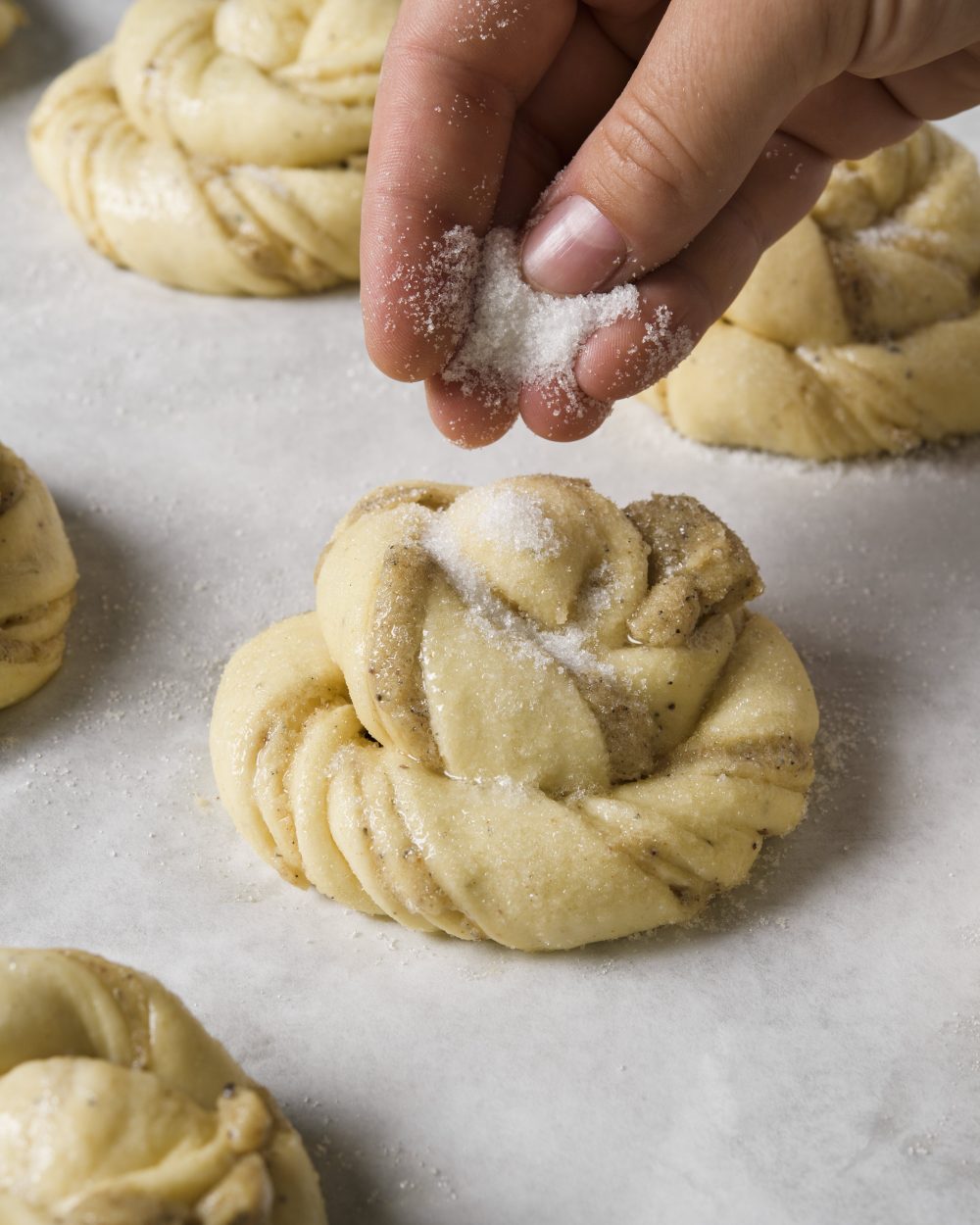An unmistakable scent lingers in the air on Kungsgatan Street in central Stockholm, invitingly warm and sweet, yet bright, citrusy and reminiscent of the pine forests that cover southern Sweden. Mingling with the yeasty aromas of baking dough, butter and sugar, it’s the commanding presence of kardemummabullar luring customers into the Vete-Katten cafe.
“I live 800 meters from here, and when the wind is right, I can feel the smell of new-baked cardamom buns at home,” says owner and pastry chef Johan Sandelin. “If customers are 500 meters away and smell cardamom, they say, ‘Then maybe we should have a bun.’ Good ad money spent, and you can actually sell it afterwards.”
The glistening, golden sweet knots in Vete-Katten’s brass-trimmed glass cases are run through with cardamom, a spice that can feel both foreign and familiar. To most Americans, it’s more associated with savory dishes, such as a surprising burst of floral flavor in an Indian curry. But to Swedes, it’s indelibly linked to baking, perfuming the dough and buttery filling of kardemummabullar, as well as the equally beloved kanelbullar, or cinnamon buns. Even more cardamom is sprinkled on top, along with a dusting of sugar that adds a delicate crunch.

Though a pinch goes a long way, Swedes eat about 60 times as much cardamom as Americans each year. Sandelin estimates he goes through several hundred kilos annually, enough that they joke that if the building burned to the ground, the smell of cardamom would remain.
The astonishing volume reflects Swedes’ devotion to another beloved tradition, the fika, an untranslatable word that equates to a coffee break. But the fika amounts to much more, a moment to relax alone or with friends, always paired with a treat, often kardemummabullar.
“When you say to a friend you haven’t seen in a long time, instead of saying, ‘Hey, let’s have lunch,’ you say, ‘Do you want to have a fika?’” says Klara von Euler, head baker at the New York outpost of Fabrique, which has several locations in Stockholm, including on Kungsgatan Street. And to von Euler, cardamom buns are so commonly linked to a classic fika spread that she didn’t consider them special until she interned at a bakery in the Netherlands. “I never knew this wasn’t a thing that was all around the world,” she says.
But special they are. Only slightly sweet and redolent of spice, the buns have a sugary crunch and a chewy bite yet remain fluffy inside. The dough is fairly simple—besides the cardamom, only flour, sugar, yeast and lots of butter—but von Euler kneads the dough for about 20 minutes, which promotes gluten formation that gives the buns their elasticity. The dough then rises overnight before it’s cut and shaped, and a second rise ensures they come out light and pillowy.
Much of the appeal of kardemummabullar is due to the buns’ unique twisted shape. A relatively wet dough is rolled out flat and spread with cardamom-sugar filling before it’s folded, rolled again and cut into strips. The strips are stretched and wrapped around the baker’s index and middle fingers several times before the ends are tucked into the center. The thickness of each strip depends on the bakery—Fabrique’s buns resemble a convoluted soft pretzel, while Vete-Katten’s are more like a tangled ball of thick yarn—but the knot contributes to the buns’ textural variety.
The buns bake in a 400°F oven, hot enough to create the crunchy exterior prized by Swedes. And some of the filling oozes out of the seams, cooling to leave a crispy, candylike crust on the bottom.
These cardamom buns checked all our boxes for a perfect coffee-break treat, richly indulgent without being too sweet or overly heavy. Because the dough is quite soft for a baked good, we simplified the shaping to make them more accessible for home cooks. Twisting the strips into a spiral before coiling them and tucking in the ends helped keep the dough from unwinding during baking but still lent the contrasting texture.
Like bakers in Sweden, we made sure to coarsely grind green cardamom seeds—the preground spice lacks flavor—to provide punctuated accent notes against the overall richness and sweetness of the dough. We chose light brown sugar in the filling over white granulated for its more complex flavor and molasses notes, and because it retains moisture better. And we took care to balance the sugar in the filling in relation to the dough, which allowed the cardamom flavor to stand out even more.
With a few tweaks, these aromatic buns came out with the right balance of floral cardamom flavor and buttery filling—the perfect treat for relaxing, alone or with friends.
A spice that originated in South India, cardamom has been adopted by cuisines around the world. The two most common varieties of cardamom, green and black, are seed pods harvested from plants belonging to the ginger family. But as siblings go, they’re very different.
Dubbed “the queen of spices” in India, green cardamom is sweetly floral with hints of pine, citrus and eucalyptus, while the black variety is smoky and pungent. The flavor of either can be expressed in different ways, whether simmered whole in liquid to mildly perfume dishes, coarsely cracked to add a sharper note or finely ground to fully meld with other flavors. And then there’s white cardamom, which is in fact green cardamom that has been bleached; this type is used only when cooks want a uniform white color with a hint of cardamom flavor.
As with many spices, freshly ground cardamom is more potent than the preground version. One convenient way to get more robust cardamom flavor is to search out “decorticated” cardamom—which are seeds that have been removed from the inedible pod shell—and grind them as needed.





